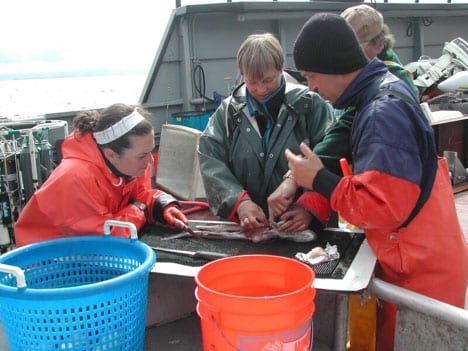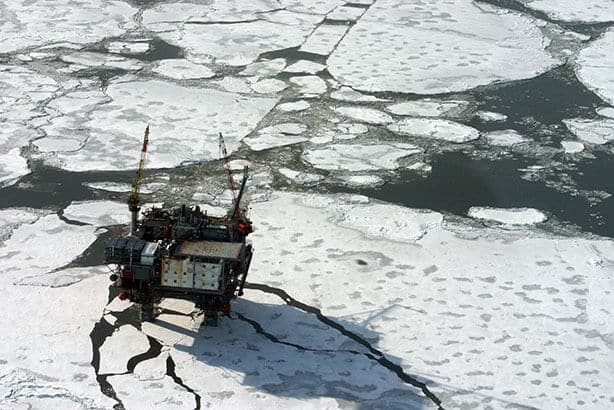Assessing the Risks in Cook Inlet
To understand the risks of oil industry operations to Cook Inlet’s environment, it’s important to know which activities pose the greatest threats and what can be impacted. Oil exploration, development, and production activities in Cook Inlet known to jeopardize the environment range from permitted contaminant discharges such as produced water, drilling muds and cuttings; oil spills from vessels, blowouts, or leaking pipelines; and noise from exploration, development, or production activities. Additionally, natural processes can magnify the dangers. This section discusses the greatest threats to Cook Inlet, and highlights the importance of the Cook Inlet Navigational Risk Assessment for identifying options to reduce those risks.
CIRCAC provides data and advice to help managers and responders make better decisions about the acceptability of risks of oil production and transportation in our area of concern; we recommend, develop and promote measures to mitigate those risks. Following years of declining industry activity, lower Cook Inlet is facing potential new pressure from planned federal lease sales necessitating work to assess unique habitats.
Cook Inlet’s tides are some of the most extreme in the world and the massive volumes of water moving in and out of the Inlet produce dangerous tidal currents. The moving water interacts through friction with the shape of the Inlet’s seafloor and creates unique convergence zones known as “tide rips” that can collect debris and ice.
Propelled by tidal currents and wind, Cook Inlet sea ice represents one of the greatest dangers to navigation and marine structures. This mobile ice can have a substantial impact on human activities and impede vessel transits. Instances where sea ice played a role in tanker accidents are well documented. In February 1999, moving ice pushed the Ocean Laurel into Unocal’s dock at Nikiski, damaging the dock and catwalk. A week later, the Chesapeake Trader was damaged and spilled 420 gallons of crude oil after colliding with a heavy ice floe. In 2002, sea ice pinned the Monarch to a Cook Inlet platform; she subsequently sank. Ice also played a role when the Seabulk Pride broke away from its moorings at the Nikiski dock and grounded off of East Forelands in 2006.
There are four active volcanoes in the region, Mount Augustine, Mount Iliamna, Mount Redoubt and Mount Spur which pose risks to oil industry operations in the Inlet. During the eruption of Mt. Redoubt in 2009, the Drift River Oil Terminal tank farm was taken out of commission and Cook Inlet oil production temporarily suspended when lahars (mud and debris flows) from the volcano inundated the Drift River valley. Ultimately, containment berms protected the tanks themselves, but required extensive reinforcement for future protection. CIRCAC has since adopted a position: the preferred long-term option is to replace the terminal and its associated tankers with a subsea crude oil transmission pipeline to transport oil from west side production operations to the refinery on the east side of Cook Inlet. While recognizing that undersea pipelines also pose risks of oil spills to Cook Inlet, our opinion is that they are less than those posed by storing oil in tanks or loading oil onto tankers at this facility.
COOK INLET INFRASTRUCTURE
Cook Inlet has been home to offshore oil and gas development since the 1960s and associated infrastructure includes platforms, pipelines, tank storage, and transportation, with hundreds of miles of crude oil, natural gas or and/or produced water pipelines—all potential threats for crude oil spills to the Inlet.
Within its first few years of operation, CIRCAC conducted a Facilities Inventory and subsequent Facilities Design Study to obtain detailed specifications and building plans for each of the permanent Cook Inlet platforms and industry docks.


Today, there are 16 offshore platforms, some shut-in. Those still producing account for approximately 16,000 barrels of crude oil per day which may increase in the future. The Inlet has seen jack up rigs used to aid exploration efforts and the installation of a new platform for gas production which can be expanded for oil production. Another operator is progressing toward onshore exploration /production in southern Cook Inlet that will draw from offshore oil reservoirs adding to crude oil production totals. The ever evolving oil and gas industry based within the Cook Inlet basin continues to experience its ups and downs with the cost of crude oil tumbling to record lows from record high values. These changes, while uncertain and sometimes unwelcome, influence the face of industry and its operations. As Inlet exploration and production waxes and wanes we can be certain that new infrastructure will be added as old assets are removed or renovated to match the need.
HUMAN FACTORS & VESSEL TRAFFIC
We evaluate risks with the understanding that human error accounts for the highest percentage and greatest potential for oil spills. When CIRCAC first started in 1990, research about human factor issues on tank vessels such as manning levels, work schedules, rotations, decision-making automated production pressures and vessel traffic systems was non-existent in Alaska.
CIRCAC worked with the Prince William Sound RCAC to conduct a needs assessment for human research factors. Through structured interviews of members of the maritime community, including ship masters and crew, U.S. Coast Guard personnel, state- regulators, shipping company executives, response and escort vessel personnel, marine pilots, and shoreside workers, the project team isolated two broad categories: individual human operator focus and organizational system focus. Sixty-eight issues were identified for oversight agencies, mariners, and CIRCAC to develop future research programs providing the basis for informed policy decisions.
ASSESSING RISKS TO NAVIGATION

In our 25th year, CIRCAC accomplished one of its highest priorities: completion of a comprehensive Navigational Risk Assessment for Cook Inlet. CIRCAC considered the Risk Assessment a necessity to preventing another spill of the magnitude of the Exxon Valdez and immediately directed our efforts toward achieving this goal. Within our first year of existence, we completed a review of vessel navigation, pilotage, terminal operations, oil spill contingency plans and risk assessment issues in Cook Inlet. We assessed vessel traffic, facility operations; oceanographic, environmental and pipeline conditions; response equipment, personnel and training for oil spill response. We assisted in state and federal efforts to conduct and administer navigational and infrastructure risk assessments that address Cook Inlet’s unique conditions. We also convened the first Safety of Navigation Forum, participated in a three-year study of the Safety and Efficiency of Navigation in Cook Inlet and Safety of Navigation in Cook Inlet forum, and commissioned a Vessel Traffic study.
Incidents such as the grounding of the Seabulk Pride in 2006, followed by a second Navigational Safety Forum confirmed what we already knew. In 2015, after devoting years to meetings, studies, and public forums led by a Management Team and Advisory Panel of Experts, the Cook Inlet Navigational Risk Assessment was finalized.
This assessment and the studies leading up to its final recommendations motivated significant changes for improving navigation safety, including updating existing navigation safety measures, amending the Cook Inlet winter ice rules, and creating the ice forecasting camera network. Chief among them was implementing the Risk Assessment’s highest priority recommendations–the immediate formation of the Cook Inlet Harbor Safety Committee.
Cook Inlet Harbor Safety Committee
Harbor Safety Committees (HSC) have proven to be effective and recognized forums throughout the Lower 48 for enhancing marine safety and environmental stewardship. They provide a collaborative environment for identifying, assessing, planning, communicating and implementing operational and environmental practices beyond statutory and regulatory requirements for safer, efficient, and environmentally sound maritime operations.
Cook Inlet HSC’s primary focus is maritime safety, preventing accidents and managing waterways and will consider prevention and response planning. As a subject matter expert for Cook Inlet, the HSC will provide a forum for maritime stakeholders to work together to identify and resolve, whenever possible, Cook Inlet’s waterway management issues.
CHRONIC DISCHARGES
Under federal and state authorities, various oil industry waste streams are permitted for discharge to the waters of Cook Inlet. These National Pollutant Discharge Elimination System (NPDES) and Alaska Pollutant Discharge Elimination System (APDES) permits allow certain quantities or concentrations of environmental pollutants to be discharged and to violate water quality standards within defined waterbody areas called Mixing Zones. CIRCAC is involved in the review process for these permits and submitted recommendations to the draft permits and associated documents such as the Ocean Discharge Criteria Evaluation and Environmental Impact Statements.
NPDES and APDES discharges are reported by each facility covered under the permit through their monthly Discharge Monitoring Reports (DMRs). CIRCAC receives copies of the DMRs and is working to compile and develop an easy-access database that will ease data analysis and visualization for overall discharge volumes and concentrations in the Inlet.
Monitoring Impacts from Identified Threats
CIRCAC’s environmental monitoring activities have been designed to assess potential impacts of the threats identified above, with a focus on contaminant analyses. During the first two years after CIRCAC was formed, the Environmental Monitoring Committee (EMC) worked with the public, agencies, and specialists to develop its first environmental monitoring program (described in a separate section). During this process, the committee agreed that the largest data gap for understanding potential environmental impacts by oil industry operations in Cook Inlet was whether produced water hydrocarbons were accumulating or impacting Cook Inlet’s environment. Produced water is water that comes to the surface with oil and gas and contains many chemical constituents, including hydrocarbons. Assessing these potential impacts and developing an understanding of Cook Inlet natural background concentrations of many of the contaminants has been the focus of CIRCAC’s Environmental Monitoring Committee over that past 25 years. These activities are described in the next section Monitoring and Assessing the Threats.












